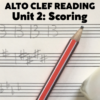(Tip no. 94 from 100 MORE Orchestration Tips, to be released in 2019)
The pro concert violist’s capacity to read ledger lines is usually greater than a developing orchestrator supposes. Frequently changing to treble staff because of a few ledger lines isn’t helpful to the player.
Another frequently-asked question is at what point should a viola part change from alto to treble clef? The problem is two-fold: the developing orchestrator’s unfamiliarity with alto clef reading, and perhaps undue concern over scoring too many ledger lines. The result is parts that are constantly shifting between alto and treble clefs, like so:
This over-helpfulness is the kind of thing that does more damage than the orchestrator realises. It’s far more difficult to shift back and forth between clefs frequently for a string player than to read a few extra ledger lines here and there. It’s also not especially helpful for a viola part to be scored throughout in treble clef when the notes are easily within the range of the alto clef – though either way is perfectly readable for the player.
The reason why is more than just convenience of reading or familiarity with one clef or another. It has to do with the violist’s strong associations of fingering positions to notes written on a staff. A keyboard-trained composer may think of a staff as a grid representing every key in its place, across which their fingers may roam – but a string player sees a staff as a navigation device charting fingering positions on a fingerboard. There’s a natural flow to the fingers over certain registers of their instruments.
For the violist, this association of fingerings naturally includes ledger lines – because for their first string, the A, the first normally fingered note is first-ledger-line B4, and first position ends with second-ledger-space E above the alto clef. Third position, which is probably the most comfortable and natural position for the player’s left hand, reaches above the treble staff itself all the way up to G5 on top of the treble clef, which in alto clef is merely the third ledger space above. Fifth position reaches all the way up to B5, the fourth ledger space, which is still a fairly common note for a violist to read.
But it’s not enough to think purely in terms of what note the violist can reach in which position, and how high it’s written on the first string. As I wrote above, there is a natural flow to the fingers over certain registers – and that flow is also from string to string. Simply looking at viola scales on the first and second strings, we see how the association of fingerings to alto clef positions is crucial to the natural reading of the violist – and how ledger lines fit naturally into that scheme. Changing to treble clef when the notes get high just forces the player to readjust that visual association back and forth constantly.
So when and how should you score viola in treble clef? Instead of the brutally simple calculation of not writing too many ledger lines, use the elegant approach of thinking in fingering positions. I personally use fifth position as the gateway between alto and treble clefs. Though it’s hard to boil down a very subjective approach into some hard, cold guidelines, here’s a checklist to show how you might apply it:



In conclusion, it’s interesting to note that composers have tended to trust the viola player’s competence in reading quite high scoring in alto clef; so a few notes here or there sitting atop stacks of ledger lines are par for the course.














